My Best Salvage Yard Adventure
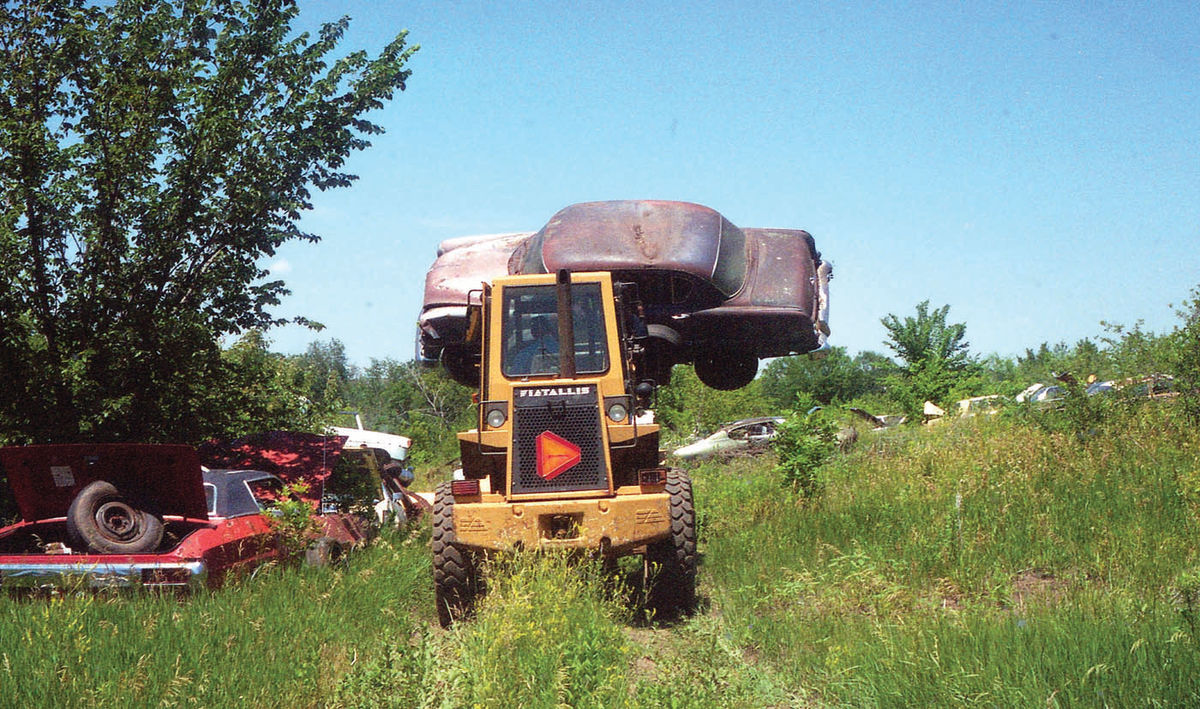
The ’53 Plymouth Would Be a Great Parts Car, But It Had Sunk Into the Dirt and Was Blocked by Trees. It Was Time for Some Serious Action.
In the realm of old cars, I’m always delighted to be out standing in my field.
No, make that “yard,” as in salvage yard(s), where I’ve experienced more pure entertainment and man-versus-nature struggles than I could relate in a book.
But if you were to ask which of those encounters stands out the most in my mind, I’d say I notched perhaps my greatest junkyard victory 16 years ago…in tiny Malcolm, Nebraska, population 375.
The episode began in June 2001 when I got word that Dale “Walkie” Walkinshaw had been unable to find a buyer for his salvage yard. It contained some 3000 cars, both late-model and older autos.
Walkie’s is Closing!
Consequently, Walkie’s Auto Salvage of Malcolm had already begun crushing its inventory; it would soon close its gates for good. In the meantime, Walkie’s was offering some fabulous deals.
The deals, I learned during a visit to the yard, included $100 for a mostly complete 1953 Plymouth 4-door sedan. From this very car back in 1989, I’d removed two wheels and a few smaller items to get a newly purchased 1953 Plymouth station wagon up and running.
First You Have to Locate It, In the Brush
Two noteworthy stipulations attended the low-low $100 sticker price on the Plymouth:
One, I had to find the car, no easy task at the old-time yard notable for its rugged hills, general wilderness, rutted trails and the random scattering of cars like so many sown seeds.

Fortunately, I only had to search about 20 minutes in the yard’s southwestern corner, a particularly overgrown area where most of the oldest cars resided, before locating the relic.
There, buried in thick underbrush, the car—despite the dead tree limbs across its trunk and cowl—looked much as it had back in 1989.
Uh-Oh…Nature Had Claimed the Car
Then there was the second stipulation attending the $100 price tag: I had to free the car from Nature’s clutches. Besides hacking a trail through the forest, Lewis & Clark-style, I’d have to play archaeologist: Missing all four of its wheels, the Plymouth Had settled firmly into the ground.
The effort seemed worth it, however. Despite missing some exterior trim pieces, the 4-door Plymouth was a treasure trove of parts.
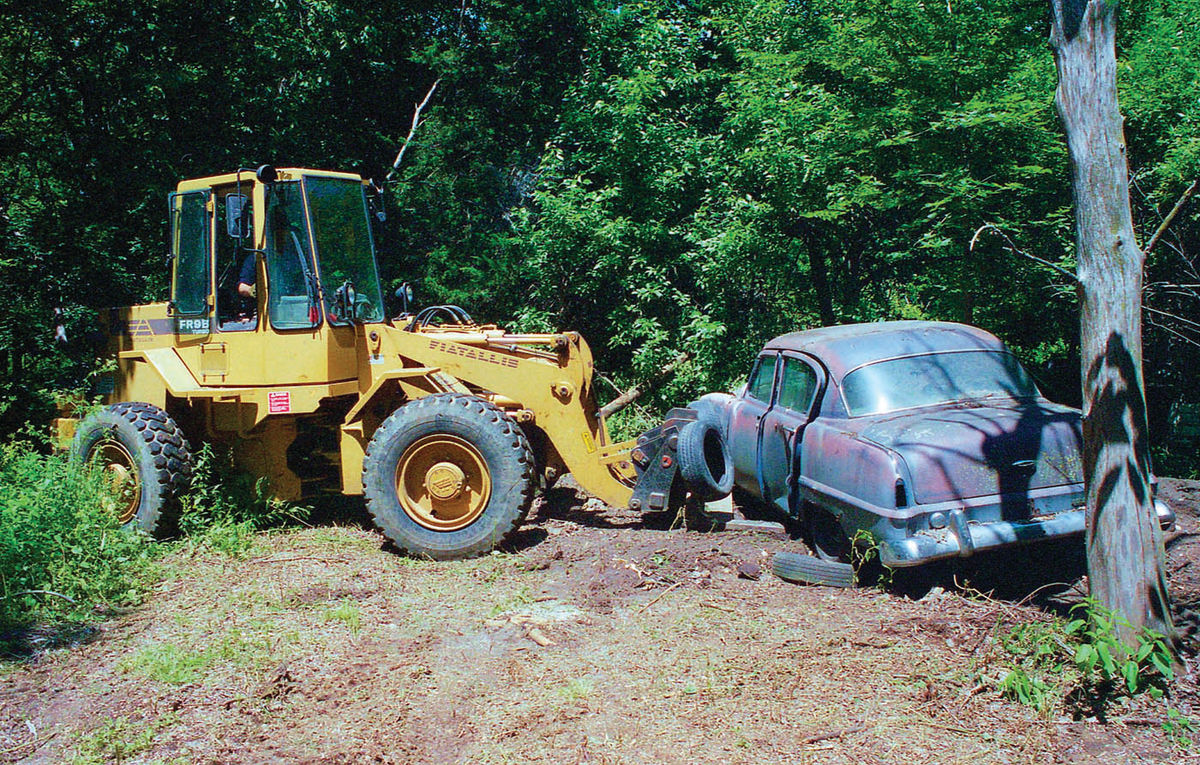
The good regarding the car: Its engine compartment seemed complete, aside from a missing radiator and air cleaner. All window glass was intact; it had two beautiful bumpers, still nicely chromed, and inside it even sported a wellpreserved gauge cluster.
And then there was the bad news: A crumpled left front fender, creased left rear door, large roof dent, some rust in the quarter panels and rusty floors in the passenger compartment and trunk.
But most of the “bad” entries in this ledger didn’t concern me; sheet metal generally doesn’t interchange between a sedan and a station wagon, after all.
So a week after my initial visit, I returned to rescue the Plymouth.
My first challenge came in merely reaching the car. It took me a quarterhour to drive my tool-laden pickup, gingerly, along the steep and winding trails leading to the yard’s hinterland.
A Shady, Overgrown Grove
The Plymouth was situated in a grove of trees which thankfully provided shade for working on a typically sunny, humid and 95-degree June day in Nebraska. But the trees also added greatly to my workload by forcing me to park 50 feet away from the Plymouth. Furthermore, two trees growing right next to the car blocked its exit.
From an array of unlikely automotive tools in the back of my pickup I selected a corn knife—a blunt-tipped machete— to begin hacking a 15-foot-wide trail through the tall weeds and grass.
After raking the fallen weeds off to the side of the trail, I unloaded and fired up my old Craftsman push power mower. By this means I buzzed the weed stubble low to the ground. I had no desire to step in an unseen hole and fall while lugging my 75-pound floor jack back to the Plymouth.
Besides, I eventually would need the wide, well-defined pathway so I could back in my trailer to load the car.
The Plymouth was facing generally north. To extract it, I needed to pull its back end out to the west, a route blocked by a tree growing about 10 feet off the car’s left quarter panel. For this very purpose I’d brought a chainsaw that made quick work of the approximately 10-year-old, 5-inch-diameter tree.
I cut down a second tree of nearly the same size growing just behind the rear bumper. The fallen trees were small enough that I was able to muscle them, whole, off to one side.
Now, with a floor jack that I placed on a piece of sturdy plywood, I was able to jack up under the rear bumper to raise the car’s back end.
This Car Is Stuck. Can You Dig It?
When the left rear hub pulled out of the dirt, I dug enough dirt from beneath it so I could place a small bottle jack under the front of the leaf spring. By this means I raised the hub several inches higher.
I then had just enough room to slip over the hub one of the four “rescue rims” and tires that I’d removed from my running, driving 1939 Plymouth.
By now it was 4:30 p.m., time to end the full afternoon’s work that represented Day 1 of my Plymouth Recovery Effort.
Unfortunately, I’d spent only a portion of the afternoon actually working at Walkie’s. Right after lunch, from 12:30 to 1:45 p.m., I’d loaded my truck with tools and placed my 1939 Plymouth on jack stands so I could borrow its wheels and tires.
Following a 30-minute drive from Lincoln to Malcolm, I’d arrived at Walkie’s at about 2:15 p.m. Subtracting the 15 minutes I’d spent driving back to the car, I’d had just two hours available—from 2:30 to 4:30 p.m.—to clear a path, cut two trees, jack up the ’53 Plymouth’s back end and fit one wheel on the car.
I then started packing up at 4:30 p.m. so I could exit the yard by its 5 p.m. closing time. I’d have to come back the following day to finish the job.
A Rain Delay Leads to a Nervous Interlude
I’d expected to be back at work bright and early the next morning. Overnight, however, a heavy thunderstorm rendered the steep dirt trails at Walkie’s too greasy to drive on for the next several days.
Meanwhile, I waited nervously in Lincoln, regretting that I’d left a nice original 1939 Plymouth rim and nearly new tire bolted to the parts car at Walkie’s. Though I’d tried to hide it from view by propping an old rim and tire against it, I realized that anyone could spot it and make off with it.
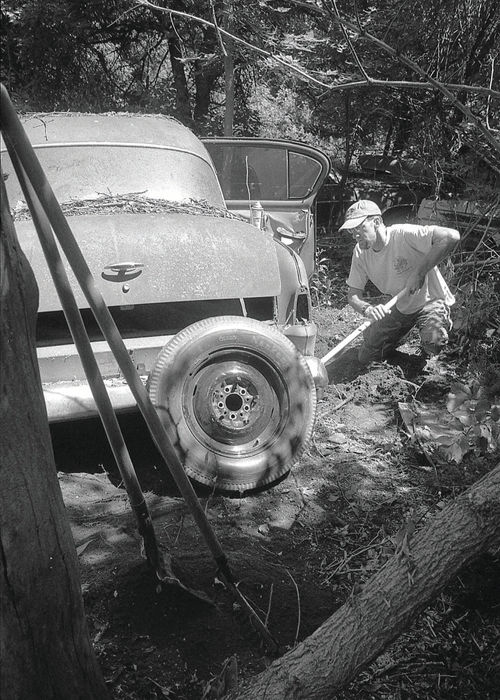
Following four suspenseful days of waiting for the ground to dry, I returned to Walkie’s. Back at the car, I discovered my ’39 Plymouth’s rim and tire exactly where I’d left them.
It’s Time to Dig and Lift
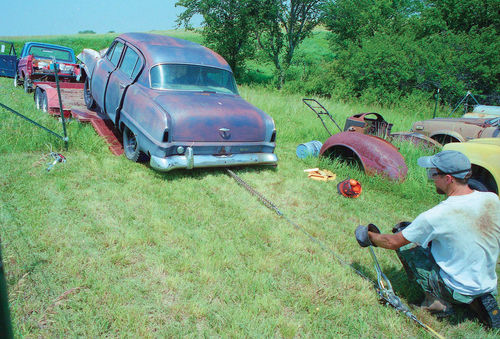
During a final four-hour session to prepare the car for loading, I resumed work at the ’53 Plymouth’s rear end. This time, I dug out and slipped my floor jack under the right rear spring.
Raising that corner of the car, I removed a half-sized concrete block from under the right rear hub. (It’s possible I had placed it there when I removed the car’s two right-side rims back in 1989!) I then placed the block under the frame just ahead of the spring and slipped a wheel onto the hub.
With the back of the car sitting a ways off the ground at last, I positioned myself at the rear bumper and used my trusty shovel to dig out under the gas tank and rear axle.
When I’d removed enough dirt, I slid my floor jack directly under the differential. By this means I jacked the car’s back end high enough to slip some junk rims from other cars in the holes I’d dug under both rear hubs.
When I released the jack, the back of the old Plymouth sat much higher than formerly.
Next I positioned the floor jack under the frame beneath the driver’s door after digging out there. Some digging under the left front hub allowed me to pop on a wheel at that corner. I repeated the job on the opposite side of the frame to install the fourth and final rescue rim at the car’s right front corner.
Problem: The Brakes Are Frozen Solution: Pick the Car Up & Carry It
My original plan had been to drive in with a car-hauling trailer behind my truck, winch the car onto it and go my merry way.
This probably had been wishful thinking, given the yard’s tortuous trails. Anyway, I’d discarded the idea on Day 1 upon discovering that the left rear brake drum was stuck. I subsequently found that all four brake drums, due to years spent sitting in the dirt, were frozen with rust.
The other option was for one of the yard’s employees to remove the car with a front-end loader. I was leery of this when Walkinshaw told me the loader’s long forks typically “take out” a car’s driveshaft.
Once I’d jacked the Plymouth high enough to peer beneath it, however, I saw its driveshaft was positioned well above the bottom of the frame where the loader’s forks would lift the car.
Accordingly, yard employee “Marvelous Mark” did a masterful job of transporting my buried treasure with a front-end loader. He moved the car breathtakingly high in the air to clear other junkers that closely lined the lane out. At other times, he nimbly maneuvered the huge loader left and right as necessary to clear trees and such obstacles as a parts-storage trailer near the entrance to the yard. He even set the car down without damaging the fenders on my trailer.
While the car was aloft, I noticed that its oil pan, despite years of sitting directly on the ground, was neither dented nor rusted out.
Saved by a Deadman
So now the Plymouth and I had made it safely home. Still, my adventure was far from over.
I had to unload a car whose wheels wouldn’t turn. But how?
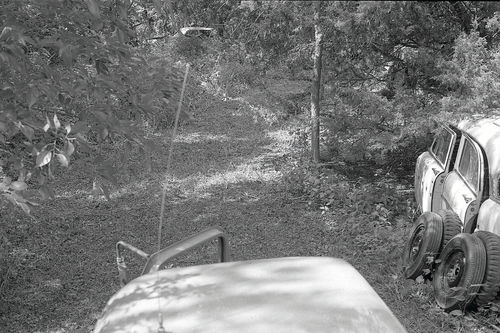

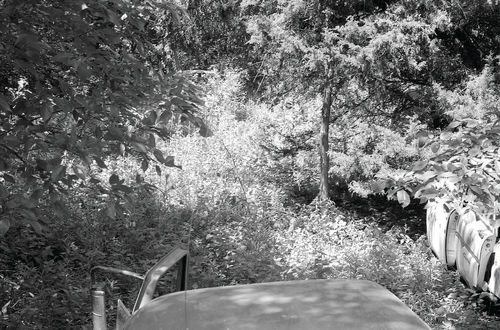
After backing the trailered Plymouth into a fenced outdoor “Car Corral” on my farm, I pounded a deadman stake into the ground 30 feet behind the trailer. The stake is a 1-inch-diameter, 3-foot-long rod with an integral baffle that prevents it from pulling out of the ground. It is firmly planted, like a dead man, and served admirably as an anchor.
To a hook atop the deadman, I attached a 20- foot log chain, a yellow nylon tow strap and two come-alongs (manual ratcheting winches).
My other secret for moving the recalcitrant car: I wet down the metal trailer floor behind each wheel and then applied Dawn dishwashing liquid—and lots of it—to grease a trail.
Once the car was on the ground, I even wet down the grass behind each wheel so I could winch it backward into place, whereupon I blocked it up to prevent it from again sinking into the ground.
An Expensive $100 Car
I could tell by the flex when I rapped on the oil pan that its bottom had been weakened by rust. Then I found it: a pinky-tip of a rust hole in the pan’s lower left side. When I popped the pan’s drain plug, some tiny chewed nuts fell out!
When I replaced the oil pan with a solid spare I had on hand, I discovered that the old pan was full of mice nests. The varmints apparently climbed in through the hole where the fuel pump had been—a missing engine part that I hadn’t noticed until now. I cut and bolted a metal cover over this opening.
Because I know that, given enough time, concrete blocks will settle into the dirt, I scavenged and mounted four free tires from a tire shop’s discard pile—a further barrier between the car and the ground.
To pickle the car against further deterioration, I drained the gas tank— mostly water, I noted—and drained and then refilled the transmission and differential with fresh 80W-90 gear oil. I also greased the zerks to prevent suspension parts from rusting solid.
Whew! When I figure in the time and energy I’d expended, my new 1953 Plymouth sedan turned out to be the most expensive $100 parts car I ever bought.
But Was It Worth the Effort?
As a postscript, I don’t recall having transferred a single part thus far from the weathered old 4-door to my station wagon.
But all is well! When I mow around it, which is regularly, I cherish the remembered excitement of retrieving it back in 2001 and look forward to the day when, inevitably, it will be of use to me.















